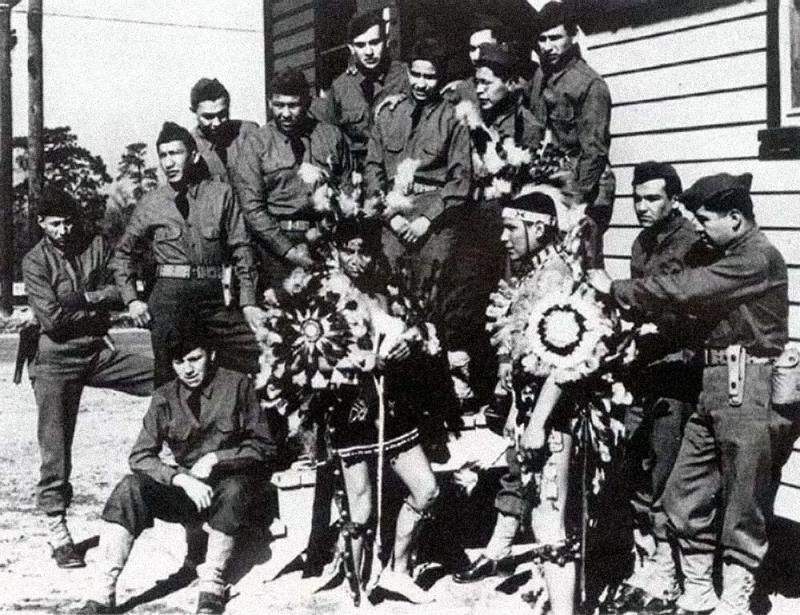Code Talkers—The Navajo Soldiers of WWII
Lesson Plan

Comanche Code-Talkers of the 4th Signal Company
Concept / Topic To Teach:
The unique role that the Navajo secret codes played in winning WWII.
Grade Level:
6-8
Standards Addressed:
Acquisition of Vocabulary and Literary Text Standard
Duration:
Two Weeks
General Goal(s):
For students to actively engage in reading a historical fiction account of a Navajo soldier.
Specific Objectives:
1. Use context clues and text structures to determine the meaning of new vocabulary.
2. Differentiate the points of view in a narrative text.
Required Materials:
Code Talker by Joseph Bruchac.
Primary Sources Used:
Novel, encyclopedias, various children’s books on codes like Morse code etc.
Warm-up:
Ask the class the following question: “If you could not communicate with others using the English language, what are some other ways you could? (Possible answers: sign language, flag codes/symbols, Morse code, etc.)
Step-By-Step Procedures:
THIS LESSON PLAN WILL BE AN ONGOING ONE THROUGHOUT THE TWO WEEKS AS WE READ THE BOOK.
Step One:
Ask the class the warm up question. Allow all possible answers. (Having already prepared the back table of the classroom with encyclopedias and other resources on communication available, direct students to choose a partner and take around 10-15 minutes to look up information on a given method of communication. Next, gather the class back together and allow each group to share their information with the whole class.
Step Two:
Hand out the novel and explain to the students that they will be reading a fictional account based on the real story of the code talkers of WWII. (You may want to remind students that historical fiction is based on the truth but the conversations and characters of the book are generally fictional). These Navajo soldiers were able to use their native language (which was thought to be a dead language by the general public) as a secret code to help communicate between military units during the war. It was this secret code that remained unbreakable by the enemy and helped the allied forces to overcome the Japanese in the Pacific.
Step Three:
Explain that before we begin reading we need to realize that there may be words in the book that are new and you might not understand their meaning. We will be using context clue strategies to help us figure out some of the meanings of the words. This means that we need to look at the sentence as a whole to try to figure out what the meaning of the word is in the actual sentence. In addition there will be actual Navajo words that we definitely do not know and that each student will be creating a glossary of Navajo words to keep in their English folder.
Step Four:
Students will need to get out a piece of notebook paper and title it Navajo glossary. Have students take turns to read aloud the first chapter of the book. Notice the first Navajo word: Akimel O’odam, which means Pima Indian. Have the students record this. Ask the following question: From what point of view is the book written? (Grandfather’s, first person) How does this help the author to tell the story? (Possible answers: It makes you feel like you are there with the story teller).
Step Five:
Continue reading and stop to work on context clues at the top of page thirteen. Have students notice the sentence: “Like me, many of them wore family jewelry made of silver, inset with turquoise and agate and jet.” Ask students to re-read the sentence noticing any clues as to what the word “inset” might mean in regards to the jewelry. Ask for any volunteers to suggest what it means. If no one comes up with the right answer take it step by step describing the silver jewelry and then explain how the other stones are placed within the silver. This is what we mean by using context clues to determine the meaning of a word.
Homework and Practice:
Students will need to read chapter two and fill out their glossary list. In addition, students will need to find at least two non-Navajo words that they do not know and use context clues to determine the meaning. They must write these down and bring to class.
Closure (Reteach):
I have many sample fiction comprehension books with one page stories. Students can read these and use context clues to determine the meanings of the word as well as determine what point of view the story is written in.
Assessment Based On Objectives:
The above reading comprehension one page stories and their homework.
Adaptations (For Students With Learning Disabilities):
Students with learning disabilities are only required to work on their glossary list. They will not need to finish the context clues assignment.
Extensions (For Gifted Students):
Have students develop their own short coded sentence. Have them share with the class the next day how they developed their secret sentence.
Possible Connections To Other Subjects:
This lesson plan/unit would be taught in conjunction with the history class. I would try to teach this at the same time the students are studying WWII in history class.
